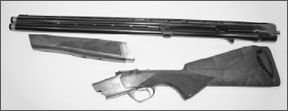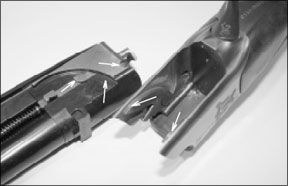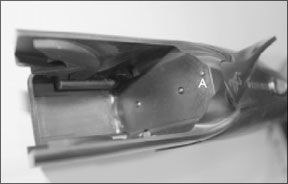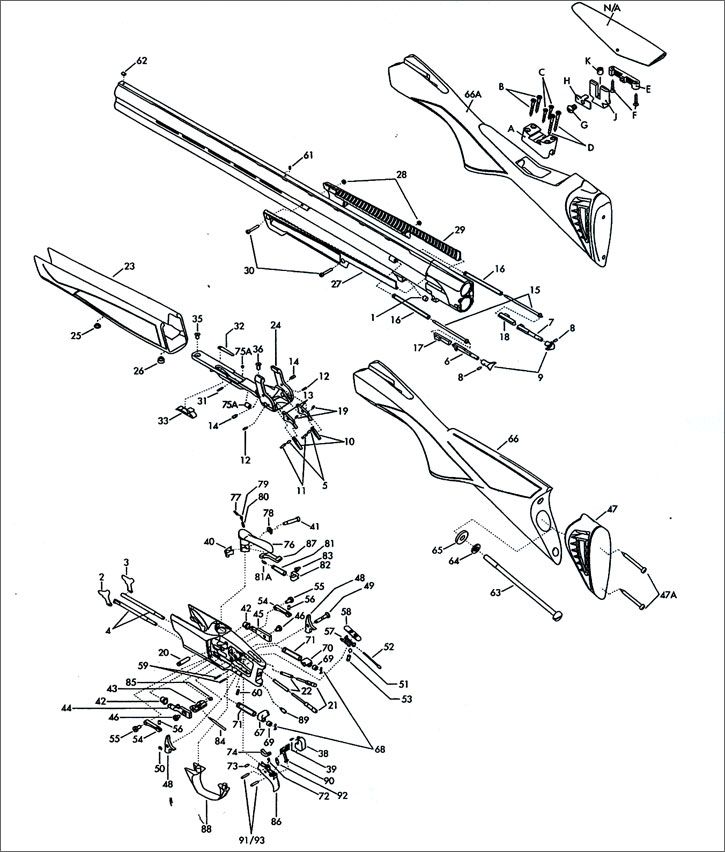To paraphrase a line from the book John M. Browning, American Gunmaker, the story of Browning’s genius is the story of the evolution of modern firearms. John M. Browning was issued 128 patents on at least 80 models in nearly every caliber from .22 Short up to the 37mm cannon shell. Those patents covered automatic, semi-automatic, lever, and pump actions. They covered gas operating systems based on the long recoil, short recoil, and blowback principles. And they covered guns using sliding locks, rotating locks, and vertical locks.

Browning’s crowning achievement–the Superposed–was designed shortly before the great inventor’s death in 1926. Built on a box-lock action, this now legendary over/under had double selective triggers when initially produced around 1930 by FN in Belgium for the European market. Val Browning, the son of John M., developed a single set trigger soon after the shotgun was introduced to these shores, which didn’t happen immediately. When Browning Arms realized the potential for sales of the Superposed on this side of the pond, a large number in numerous variations and grades got diverted to America, where they became a nearly instant success.
The purchase of an original FN-manufactured Superposed could max out a whole wallet full of credit cards. For example, a matching cased set with 12-gauge barrels sold at auction for over $25,000 in 2004. If that’s a little more than you want to spend on an old shotgun, the Browning Custom Shop still produces new ones on special order. The waiting time is six to eight months, and the cost, depending on grade, runs from about $4,500 to $14,500.
The Superposed remained top dog at Browning Arms until B.C. Miroku was selected to produce Browning’s next generation of O/U shotguns–the Citori. The Citori, introduced in 1973, also featured a box-lock action, a single selective trigger, and automatic ejectors. In the opinion of many shooters, the Citori is an “economy version” of the Superposed.
New developments in offshore-made O/Us–primarily a lower profile–prompted Browning engineers to begin rethinking the Citori design about 10 years ago The goal was to work up an over/under that was as strong as the Superposed and Citori, but with a lower profile and a trigger system closer to that of a bolt-action rifle for faster lock time. A British designer made a stab at it, failed, and the Browning engineers took over. They came up with a monoblock hinge for a lower profile and better balance, a new recoil pad, a mechanical trigger system, an optional adjustable stock comb, back-bored barrels, and impact ejectors. This new design–Browning’s third generation of O/U shotgun–is known as the Cynergy. Like the Superposed and the Citori before it, I expect the Cynergy will develop a distinguished history all its own.
Field Stripping
Field stripping an over/under hardly requires instruction, but here goes anyway. Open the action and check the chamber. Remove any shells. Swing out the forearm latch. Rotate the front end of the wood away from the lower barrel, and remove the forearm toward the muzzle. Grasp the barrels, pivot them downward and detach them from the receiver. Inspect the monoblock hinge, ejector cam, and locking-pin surfaces. If dry or fouled, clean and lubricate.

Detailed Disassembly
Relatively speaking, shotguns are somewhat more complex than other firearms. There’s more going on inside than with your average rifle, pistol, or revolver, and there are more parts interacting with others to make the weapon work. With its fair share of levers, screws, rods, springs, and pins, the Cynergy is well up near the top of the complexity scale. The detailed disassembly instructions I’m about to share with you came from one of the engineers who designed it. Ready?
Okay, you begin with the action closed. Place an 18- to 24-inch-long hardwood dowel down each barrel to prevent crushing, and secure the barrels at a 45-degree angle between padded vise jaws (just forward of where the forearm was). The stock is now tilting up and is at chest level. The recoil-pad screws (#47) on newer Cynergys have holes located immediately over them. Older Cynergys, like most long guns, have nearly invisible slits in their butt pads, so you’ll probably have to fish around to find the screws. Do your fishing with a round-shank Phillips-head screwdriver that has had its business end coated with Vaseline. Even on newer models with screw holes in the recoil pad, the Vaseline is not a bad idea. Browning puts a “vapor deposit” on these pads for added slickness so there’s less chance of the pad hanging up on a hunter’s coat when it’s being brought to shoulder. This is a good idea, but I’ve found this vapor deposit to be somewhat brittle; it can develop cracks when violated with a non-lubricated screwdriver.
On a Cynergy without an adjustable comb, once the recoil pad is out of the way, you can go in after the stock bolt (#63). The bolt has a slotted head, metric threads, and a driver with a medium-length shank will be needed to reach it. This bolt is very soundly torqued in place. I’d recommend against using a plain-blade driver for fear it might slip off the bolt head slot and fracture the stock. Look for one of those socket-wrench drivers with its blade enclosed in a cylindrical sleeve, available from automotive tool suppliers. If the washers (#64 and 65) fail to come out with the bolt, they will tumble from the butt stock the first time it is pointed to the floor.
Stock removal is a bit different on Cynergy models with adjustable combs. Look at the sub-drawing at the top of the schematic on page 5. “A” identifies the base. It’s bedded in with a proprietary compound before the screws are added. The base has a milled slot in its top that fits the dovetail in the web (J). When the web set screw (K) is loosened, the comb can be moved right or left to adjust cast. It is vertically adjusted for drop by backing off the adjustment screw (G) with a 4mm Allen wrench that’s inserted through a hole in the comb (N/A). The clever Browning engineers have replaced a slot or hex head with an Allen-head stock bolt and cut a channel in the bottom of the base. This allows the use of a T-handle wrench to reach the bolt, which need not and should not be completely backed out.
Regardless of whether the shotgun has an adjustable comb or not, the action has to remain closed to keep the top lever in its middle position while you remove the stock. In most cases, it can be pulled straight back without great resistance. A stubborn stock can be “encouraged” by using the heel of your hand to bump the pistol grip upward and wobbling it from side to side as you simultaneously tug on the back end. Why do you have to keep the top lever centered? So it won’t scrape up the stock, which it could do if the action were open.

Open the action and you’ll see what I mean. The top lever kicks to the side. While you have the gun open, run a fingertip over the upper breechface. Feel a little, hard lump? That’s the top-lever disconnector (#77). It protrudes through the breech to contact the barrels when the action is closed, and gets pushed back into the lever by the barrels and releases the lever to center on the receiver. (More about the lever and its related parts later.)
The trigger guard (#88) is retained by a screw (#89) located in the lower back end of the receiver. The guard’s front end has a “hooked-in” arrangement with the receiver. Retract the guard screw with several turns but not all the way out, then pull the guard to the rear and it drops free.
The selector button (#58) and selector (#57) are the same for all gauges. The button is retained by two pins (#59). They slide out to release the button. Take a closer look at this area on the schematic. The safety-retaining pin (#52) has to be pulled out so the selector will slide to the rear. Keep a finger over where the selector button used to be as you pull the pin; otherwise, the safety-index ball (#51) and safety spring (#53) will fly. Once controlled, they can be lifted out with a small magnet.
As mentioned, the Cynergy has a mechanical trigger system. The gun doesn’t use recoil to set up for the second shot. Instead, an inertial mass (#38) has been designed in to serve as a disconnect and prevent doubling. The mass has a roll pin (#39) attaching it to the trigger link (#90). In turn, the link is held to the trigger by the pin (#91). This entire subassembly is freed by drifting out the trigger pin and should remain as a complete subassembly. Incidentally, pins #91 and 93 are identical.
The striker stop (#74) is identified as a spring on the parts list. It’s really a weight that prevents a striker from hitting a firing pin when the trigger is depressed. Older versions of the Cynergy carried two small points on the trigger itself to catch strikers. The striker stop has had height added to it and assumed the responsibility. It’s an added safety feature against an accidental discharge if the gun is dropped, so leave the stop and trigger as is.
Both left and right rockers (#48) are interchangeable. However, they’ve been factory fitted to ensure the same trigger pull on both barrels. I recommend you mark which is left and which is right, either before or after you remove them by pushing out the rocker pin (#49). The schematic is incorrect regarding this pin. It is inserted from the left side of the receiver, not the right. Therefore, its head will be on the left and its clip (#50) on the right.
After popping off the clip, drive the pin toward its headed end. I use the term “drive” because mere drifting may not move it. Part #49 is knurled under its head to prevent the pin from rotating. If it were free to turn, firing one side could put enough pressure on the other side to double the gun. If this was a rifle, the next item to be addressed would be the primary sear. In the Cynergy, the sear links (#54) amount to the same thing. Each one is retained by a link screw (#55). A 3mm Allen wrench backs them out. The sear springs (#56) will remain in the links. They’re deliberately made larger at their seating end to stay put.

Now close the action. The left striker (#67) and right striker (#70) will move to the rear. What look like rods on the drawing are striker springs (#71). To take the strikers down further, remove the striker-nut lock pins (#68). These are cotter pins. The striker nuts (#69) resemble castle nuts. You’ll have to machine a blade screwdriver or driver bit to clear the “castle” part, reach the nut, undo it, and relieve the spring pressure.
At this point, you’ve taken out all striker components from the back of the receiver, and can move on to the locking pins (#44 and 45). Note that pin #44 is slotted to fit into the top lever. In reassembly, it must be put back where it came from. If I’m reading this drawing correctly, that means on the left side of the gun. The screws (#46) securing both locking pins are Allen heads, 3/32-inch English thread, and held in place with a mild thread-locking compound. The thread compound may fight you a little, but will “pop” audibly when you’ve torqued it enough to loosen up. When both screws have been backed out, it’s more than likely the locking-pin cross member (#43) will fall free. Hopefully, you’ll catch it. The trigger-link disconnect (#84) runs through and is retained in the cross member by another 3/32-inch set screw.
The firing pins (#21) are spring loaded (#22) and are interchangeable from one barrel to the other. Their cross pin (#20) retains them. It’s knurled at one end and has to be started right to left. Keep your thumb behind each firing pin as you push out the cross pin. When observed from inside the receiver, the firing pin holes appear to be drilled for a side-by-side double gun. They’re not. One angles up. One angles down.
The top lever (#76) is centered. Another screw (#41) wearing thread locker runs through it and threads into the locking cam (#40). The cam reaches down into the locking bolt. You can remove the screw, but the top-lever disconnector, retaining plunger, and spring (#77, 79, and 80 ) are still within the lever. Remember them as you work the lever back and forth while lifting it out–and cover the hole those parts are in until you have the lever held over a magnetic parts tray or inside a plastic bag. After you let loose, count the pieces that popped out. Parts #79 and 80 may be there. Part #77 may not. Where to look? In the receiver. Use a magnet or the indispensable paper clip. Leaving it where it is only guarantees it will fall out someday, somewhere–never to be seen again.
From where you now are, concentrate on the top-lever spring (#81). All such springs are murderously heavy and this one does double duty. It applies pressure to the trigger-bar disconnector (#87) that does likewise to the rocker(s) to take pressure off the firing pins when the action is opened. This feature cuts way down on pins getting stuck in spent primers. The trigger-bar disconnector contains a tiny roll pin (#81A). It stays where it is. You can back out the spring-stop screw (#83) if you have a 2.5mm Allen wrench handy. When you do, the top-lever spring stop (#82) will probably stay in the receiver, with its spring (#81) providing plenty of pressure. Unfortunately, to remove the stop you first have to remove the spring, but there’s no magic needed to do it. A small tool employed as a lever under the spring will start it up and on its way to out. Be aware that this spring is an independent cuss. When you have it almost out, it can decide to complete the process and say “bye-bye.” Controlling it is to your distinct advantage. Let’s suppose that spring #81 has been showing signs of weariness or is broken. To replace it, you have to push the lever-spring stop forward with a screwdriver before you can move the disconnector back through the receiver. And it ain’t real easy working against that spring.

The cocking levers (#2 and 3) along with their respective links (#4) stay with the receiver for the moment. The levers will be inside their receiver slots, and the links still through their holes in the breech face. A post on the end of each link serves as a pivot for its associated lever. Push the links forward one at a time and you can lift off its lever. After that, withdraw the links.
The trigger-guard screw remains in the receiver along with the selector pole (#60). The pole should stay put because it indexes the safety and it’s pressed in. Though not present in steel receivers, there are two hardened stainless-steel bushings pressed into the breech face of aluminum-alloy receivers. They’re not removable, but you’ll know they’re in there. All alloy Cynergy receivers are stamped “Feather.”
Now move along to the forearm bracket. Back out its front screw (#35) and rear screw (#36). The locking-lever pin (#31) gets pushed out in either direction to let go of the lever (#33). The lever spring (#32) is held in place by a standard thread screw (missing from the drawing). While the lower tension-adjustment screw (#75A) is a set screw assigned the job of tightening the bracket, once it’s tight the upper screw wearing the same number keeps it tight.
Parts remaining in the bracket are related to the ejectors. All retaining screws involved with the ejectors have been staked in to prevent rotation and thus throwing off the factory-set timing of the ejectors. As I did in the past with the Citori, I’ve decided to devote a separate article to timing Cynergy ejectors rather than include the information here. Fortunately, however, timing is much simpler with the Cynergy than with the Citori.
Which brings me to the barrel assembly and your need once again for the “castle-nut” driver you made earlier. This time it’s used to compress the spring (#16) of each spring guide (#15) individually. The ejector assemblies (parts #7, 8, 9, 17, and 18) are removed to the rear as units. Note: parts #8 are rivets, and replacements will be required if they’re taken out. The barrel bushing (#1) is another hardened insert that is press fitted and then soldered in place. All this security supposedly prevents recoil damage to the bushing.
Adjustable Stock Details
The Cynergy model I used in preparing this article had a wood stock, but no adjustable comb. Regardless, I’ll discuss why an adjustable comb is advantageous and how to adjust the one that’s available on the Cynergy.
The stock fit against a shooter’s face determines how consistently the dominant eye will align with the sight plane along the barrel rib when the gun is brought to shoulder. Cast and drop are critical factors in achieving this consistency. With right-handed shooters, “cast off” is the distance the comb must be positioned to the right to gain an ideal sight picture with no bending of the neck. “Cast on” is the distance the comb is positioned to the left to gain the same ideal for left-handers. “Drop” applies to the vertical distance between the top of the rib and the top of the comb, and the raising or lowering of the comb to provide the ideal sight picture.
What’s “ideal?” Each time the gun is shouldered, the front bead should be sitting on top of the middle bead with no rib visible between the beads. An old-time gunsmith who specialized in stock fitting once told me never to increase or decrease the length of pull after adjusting for cast and drop. “It changes the barrel-to-comb alignment,” he said. I’ve never forgotten his advice.
I’ll add another piece of advice to that of the old-timer: On Cynergy adjustables, merely loosen the comb-adjusting screw (G) by inserting an Allen wrench into the hole in the comb when moving the piece vertically. Don’t keep cranking the wrench. The insert (E) is mounted to the comb by twin screws (F). If you fail to let up on “G,” you’ll split the wood.
Reassembly Tips
I think it’s safe to assume that –sooner or later–you’ll be offered a plastic bag of parts that began life as a Cynergy shotgun. And you’ll have a choice: Either follow the sequence below for its reassembly or hand the bag back to the person who brought their problem in the door.
Reattach the cocking levers to their rods and insert the rods into the receiver. Slip the springs on the rods. Open the action to compress the springs. Reassemble the locking-pin assembly in the reverse order of the disassembly instructions. When positioning the cross member (#43), its clearance cut must face upward and the hole in the face of part must be to the rear. After the locks have been secured with the little cotter pins, the striker springs will be captured.
Install parts #77, 79, and 80 in the top lever. Depress them and cover their hole in the lever until you can insert the lever far enough into the receiver to block the hole. Insert the trigger disconnector (#87) under the top lever and rockers. Take another look at the top-lever spring. One end is smaller than the other. The small end fits over the top-lever spring pin (#81A). The larger end engages the top-lever spring stop (#82). Though you can spot its recesses fairly easily in the upper tang, the stop is somewhat tricky to reinstall. My contact at browning does it by removing the bit from a MagNaTip driver, using the bit-receptacle end of the driver to help locate the stop over its slot by forcing it forward, and then pushing the part into place. This is followed by seating the top lever, installing its locking-cam screw (#41) and locking cam.
I intentionally didn’t mention the top-lever retainer (#78) in order to emphasize the importance of one of its features. There’s an angle, or radius, on the upper-rear corner of the retainer. It has to be in that position when put back into the receiver or there’s no clearance for a firing pin to pass by. And pass by it eventually must.
If the action isn’t open, open it to lessen pressure on the striker springs. Back out the locking-pin screws just enough to drip a little blue LocTite on their threads and retighten both. But first, just to be certain you haven’t goofed up (as I did the first time around), see whether or not the locking pins (#44 and 45) are reversed. The left one wears a distinct bump to interact with the cam in the top lever. Switching these pins is absolutely verboten.
Prior to installing the firing pins, take note of their rear notches. The notch in the upper pin must face down, with the notch in the lower pin up. Thus positioned, there’ll be no interference when the cross pin (#20) is reinstalled from left to right. Both rockers (#48) come next. They’re retained by their pin (#49), which is correctly started in from left to right. This pin may have to be encouraged to complete the final 1/8 inch of its full seating. Snap on its retaining clip (#50) and then go to work on the safety.
Install the safety spring, place the index ball over it, and depress both. Start in the retaining pin (#52) enough to capture the ball. The selector (#57) has to engage the trigger link (#90) with the “fork” in the link positioned over the selector. Now you can push the retaining pin through the assembled parts, add the selector button with its longer end toward the muzzle, and then push the button pins (#59) through the receiver and assembly to hold them together.
With the action open, run a fingertip along the upper arc of the breechface to check for the presence of the top-lever disconnector. You should press it in a few times to ensure its freedom of movement.
Okay, now insert a dummy round and close the action. Did it sear up? Great. Move the safety off and pull the trigger. Striker released? Great. Open the action, close it, and snap the safety “on.” Pull the trigger. No striker fall? Great again. Take it to a range and shoot it. And finally, hand the shotgun back to its owner along with a tidy bill for services rendered.

























